
Perhaps you have been thinking for a long time that you really want a telescope but don’t quite know where to start. Perhaps, like the lady above, you don’t know how to use one at all ! Maybe you have had a look at some telescopes but the choice is a bit overwhelming, just how do you choose what will work for you ? After 20 plus years of using, selling & repairing telescopes I have these Top 10 Tips that might just narrow it down for you.
NB: See our GLOSSARY of terms to explain some of the perhaps unfamiliar terms used, these terms are marked with a * in the first instance.
- There is no PERFECT Telescope.
- “Aperture* Rules”
- Telescope “Functionality”
- Set a realistic budget.
- A stable mount* is critical.
- Avoid the “Hobby Killers”
- Care and Maintenance
- Quality Accessories matter.
- Portability & storage
- Manual vs Go-To
- 1. There is no “Perfect” telescope that meets all needs, its about choosing the scope that best suits your Primary use. The 3 main types of telescopes are Refractors, Reflectors & Cassegrain Compond Telescopes (Fig 1) Each has a different focal Length* (light Path length) which will determine Magnification* & affect the quality of the magnified object. lets go into a bit more detail on each type with their benifit’s and drawbacks.
Refractor :
The refractor is the most recognisable design with a lens at one end and eyepiece at the other. The Standard type is an Acromatic* Design and is affordable, great for terrestrial use and for casual viewing of the night sky, but suffers from some false colour on bright objects. An Aprochromatic* design eliminates this issue but is 4 to 5 times the cost. Focal length is relatively short thus giving a more “wide Field” view and a Maximum Aperture of 5″ (120mm) Both are very portable and do not require a large and heavy mount* or Tripod. This makes them quite portable and a popular choice to travel with, if you can afford the quality Aprochromatic scopes.
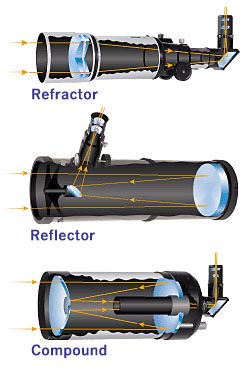
Reflector:
The reflector gives you the most bang for your buck, allowing a bigger aperture at a reasonable cost and fits into the “Aperture Rules” category (see below). It is generally mounted on a dobsonian (Fig3) mount, further reducing the cost compared to a tripod mounted scope. For example a 10″ aperture dobsonian (Dob) reflector will be lower cost than a quality 4″ ED Refractor. A typical dob will have double or triple the focal length of a refractor and thus greater magnification. The aperture in a commercially made Dob can be as large as 20″ (500mm). They would be best classified as “Semi Portable” except for the 3″ to 6″ sizes.
Compound:
The Compound scope is usually of a “Maksutov” or “Schmidt Cassegrain” design (Fig 1.). These combine the best of the refractor and the reflector and are usually mounted on a Go-To* mount. Size can be from 3″ up to 14″. However scopes above 8″ can become heavy to lift. A 3″ Go-to Compound scope starts at around $550 rising to over $14,000 for a 14″ model.
- 2. “Aperture Rules” IF you want an Astronomy telescope to see feint Comets, Nebulae, Galaxies, supernova remnants and the like (deep sky) with your own eyes (Astrophotography is another topic altogether). It is often said for this type of astronomy to “Buy as much Aperture as you can afford and are willing and able to move around” (however see tip #9). For the deep sky, the starting point is really a telescope of 6″ to 8″ of Aperture & the best value is a dobsonian mounted reflector or a Compound scope which gives greater portability than a reflector. The difference aperture makes can be clearly seen in Fig 2.
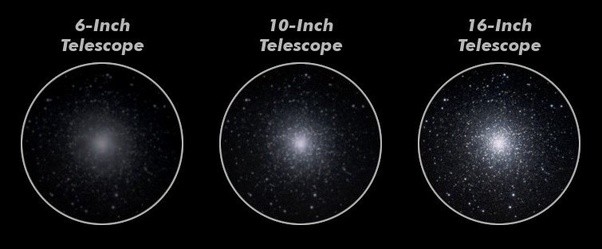
- 3. Telescope Functionality. The best telescope is “The one that you actually use”, you will use it because it is convenient for you to do so, you have the time to prepare it for use, you can see enough detail to satisfy you & it is portable enough to make all of this possible. This is very much driven by your circumstances. For this reason the 8′ to 10″ dobsonian is often the telescope of choice. Because it is Fast to set up, shows detail in the deep sky and planets, and is affordable. This brings us to Tip 4.
- 4. Set a realistic budget How much are you prepared to spend ? Allow at least $300 to $400 to get started with either a small refractor or tabletop dobsonian, If it is a first telescope for kids then there are a few options under $200 that will get them interested. Otherwise consider a good quality pair of 10×50 binoculars as a starting point. If you have around $700 to $1000 you can get up to a 10″ Dobsonian or a 5″ Compound Go-to.
5. A Stable mount. is as critical for good viewing as the telescope itself. Without this, frustration will be your constant companion as you try to observe. If the tripod is wobbly and the mount poorly constructed you will not be able to find, much less track the celestial beauties you seek. The 8″ dobsonian mounted reflector (Fig 3.) is a hands down winner here in the under $1000 range for larger aperture. With a fast set up time and very stable mount, it is easy to hand guide with the touch of a finger. The 5″ Go-To compound is a close 2nd if you really want Go-To functionality while still maintaining high magnification views of the planets on a stable mount matched to the size of the scope. With the Go to scope you can be finding 100’s of star clusters, some bright Nebula and the planets with a touch of a button.
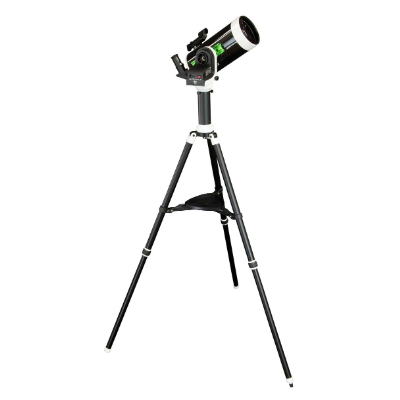
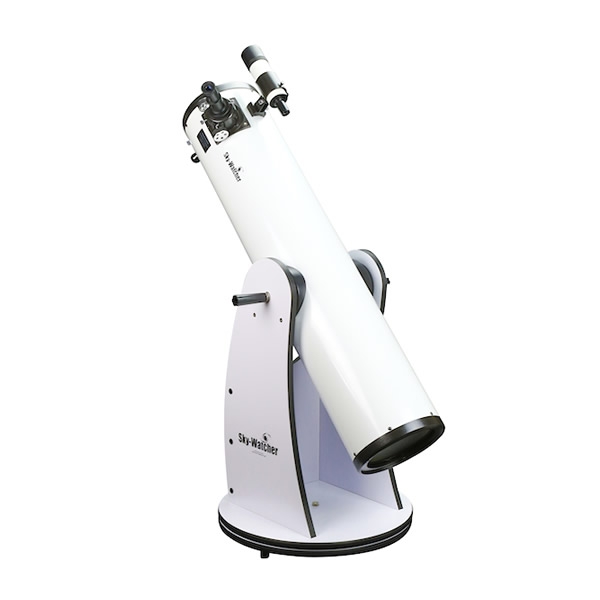
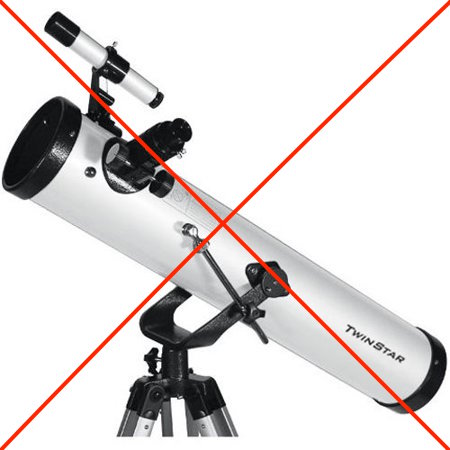
6. Avoid the “Hobby Killers”. Here I am talking about the cheap refractor or reflector on a wobbly tripod and mount, these will quickly destroy your interest whatever their intended use is. I include in this category, yoke mount (pictured here) & low end “EQ” or equatorial mounts, you will recognise EQ mounts easily as they require “counterweights” to operate. There is one other telescope to avoid and that is the “Bird-Jones” reflector. The give away here is its (for example) a 900mm focal length in a tube 600mm long & below the focuser is a corrector lens *avoid at all costs* The view is terrible & they cant be aligned. You see these and other types all the time in garage sales, being sold for $20 after the frustrated owner gets rid of the scope they have paid $150+, and bought something useless.
- 7. Consider Care & Maintenance that you are prepared to put into your telescope, as this is a factor in the type of scope you choose. Refractors are the easiest care with no alignment required, they just need to be stored with care in a dry place to avoid issues with mould. The focuser will need occasional cleaning, adjustment & lubrication. Reflectors require perhaps the most maintenance with regular “collimation” to ensure the mirrors are well aligned for sharp stellar & planetary views and usually an annual mirror clean. A good quality quartz over coated mirror should last 10 to 15 years. The timber bases are usually constructed of craft wood or the like and care must be taken to ensure they don’t deteriorate. Compound scopes are moderate in their maintenance requirements, with a perhaps twice yearly collimation & great care should be taken to avoid mould growth internally as repairs are time consuming and somewhat costly
- 8. Quality accessories matter as whichever scope you choose, their will be accessories that will greatly improve your observing experience, especially for astronomy use. The Key accessories are quality eyepieces* & selected filters* such as Lunar, Nebula & planetary. The Eyepieces that come with most telescopes are entry to mid level in quality, typically a 10 and 25mm Plossol Design. perfectly acceptable to start with, however adding at least 1 good quality widefield eyepiece (EG: 60 to 70Deg) with long eye relief* (15 to 20mm) will show you just what is possible with your telescope.
- A good quality finder scope can make all the difference too, replacing a straight through finder on a Dob, with a right angle one will revolutionise your viewing. Sometimes replacing a cheap finder with the aperture of a marker pen with a good quality red dot finder will be a better option on a rich field scope.
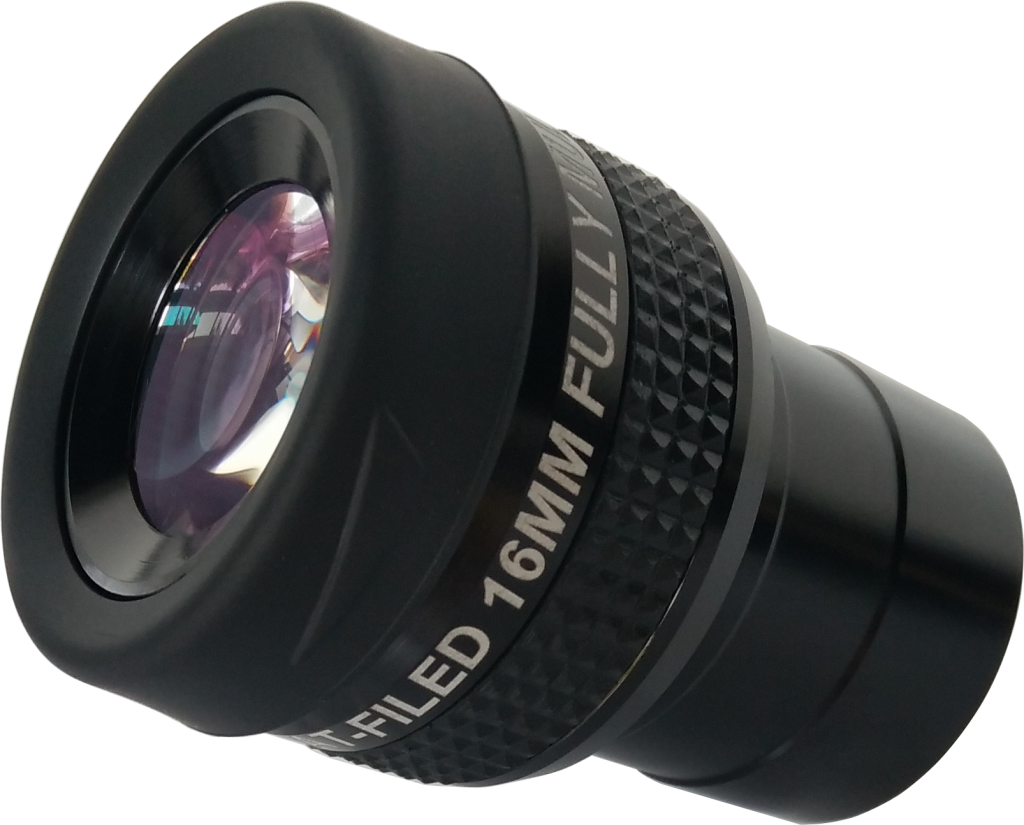
9. Portability & storage is a much bigger factor than most people realise. This is the tempering factor against Tip#2 “Aperture Rules”. The scope that takes up lots of space in your home, takes and hour to set up & may require the help of a 2nd person, is not always the best choice. We call this “Aperture fever” the overwhelming desire for bigger and bigger telescopes. Also, Perhaps you need to travel for your observing (dark skies are best for deep sky astronomy) With this in mind a 6″ collapsable tabletop under 10kg and can be stored in the closet, can be a better choice than a 16″ tracking Dobsonian that weights over 70kg and needs a van to transport, or even larger scopes. There is a scope that will suit the happy medium for everyone.
10. Manual vs Go-To: Finally, are you prepared to manually find and track your target. For daytime terrestrial observing this is simple to do manually. For astronomy though, finding and tracking objects in the night sky is an acquired skill that can take 50 plus hours of observing to master. If this is not you, and you love “Tech” want it NOW and don’t mind a 20 to 30 minute set up time, a “Go-To” telescope might be what you need (see Fig.4). A tracking scope can start from as little as $600 for a 4″ Reflector, around $3500 for an 8″ Compound to over $10k for large 20″ Truss Tube reflecting Go-To Dobsonian.
So what ever your desire, budget or skill level, we can help you at NightSkySecrets to choose the Telescope that best matches your needs & we always love to hear from you with your questions.
Glossary of Terms:
Term: | Meaning: |
Aperture | The opening at the front of the telescope is an indicator of the aperture (more is better). |
Acromatic | An uncorrected refractor with possible false colour (chromatic aberration and purple fringing). |
Apochromatic | A corrected refractor using a triplet, ED Lens, or Fluorite lens to correct false colour. |
Eyepiece | The interchangeable optical element that gives the telescope its Magnification. |
Eye Relief | Eye relief is how far your eye needs to be from the lens to see the full field of view (more is better). |
Focal Length | The length of the light path in the telescope, which is the determining factor on how much magnification a given eyepiece will deliver. |
Mount | This is the device that the telescope tube attaches to which moves the scope, and may be separate to the tripod it attaches to. |
Magnification | How many times greater than the naked eye view the eyepiece shows the magnified view. |
Wide Field Eyepiece | Field width determines how much of the sky you see for a given eyepiece magnification a Wide Field eyepiece is generally greater than 50deg & can be up to 110deg. |
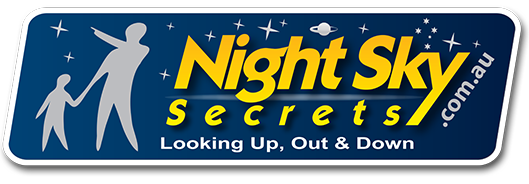
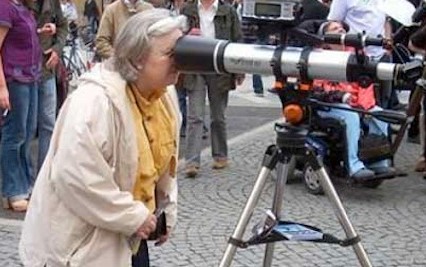
You, for some reason, forget the essential Finder Scope! – most that I have seen are useless – especially the peep hole varieties. They need to be a reasonable scope, preferably with an offset eyepiece (90 degrees to the scope body) and preferably with (illuminated) cross hairs that align with the centre of the scope field.